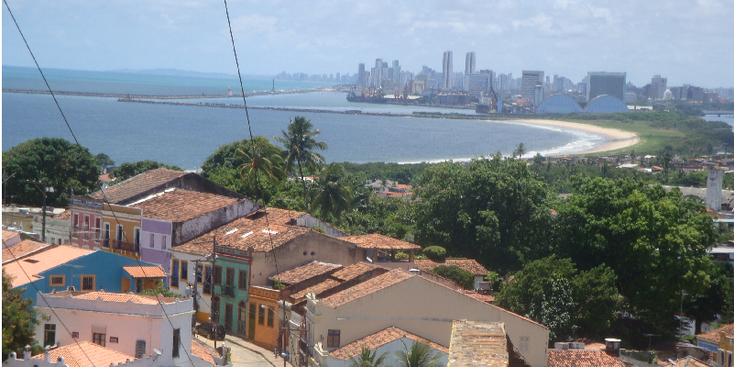Olinda (and Recife)
Places of Interest - Brazil


introduction
Olinda is a stone's throw from the capital of the province Pernambuco and is its cultural counterpart Recife. The city of Olinda has a long colonial history. In addition, in 1631 she was burned by the Dutch. Today the city is a tourist attraction. This is partly due to the historic center, which is listed as a World Heritage on the UNESCO list. Furthermore, the city attracts many tourists through the local culture, which manifests itself in various forms of music and dance, with the Carnival as the big highlight.
In 2006 Olinda was the Cultural Capital of Brazil. The historic center consists of two parts. The first is a low-lying neighborhood with narrow cobblestone streets and colored facades that lie against the sea. The second is the hill “Alto da Sé”, from where you have a beautiful view over the coast all the way to the city of Recife with his modern high buildings.
highlights

Downtown Olinda
Since Olinda (which in Portuguese means "what beautiful") does not, like many other cities in Brazil, have an impressive beach nearby, it may be a little less crowded in the center, which only sounds good to the average tourist.
The city center is a collection of beautiful old colonial buildings in all sorts of bright colors, complemented by a large number of churches, monasteries and museums. In addition, you can enjoy a beautiful view of the great city of Recife and the Atlantic Ocean.
Other attractions:
- House of the Dolls (Casa das Bonecas) which are large dolls made of papier-mâché and wore during carnival.

history

In 1534 the Portuguese came ashore and were looking for a suitable place on the coast to build a capital of the captainship (province) Pernambuco and to export the proceeds of the sugarcane plantations behind the place. They found Olinda what, among other things, had a beautiful natural harbor that could easily protect the ships from the sea. Through sugar production, and also through the extraction of brazil wood, the city gained a wealth so big that it was out-crown the capital of Portugal, Lisbon.
On 16 February 1630, under the leadership of Captain General Hendrick Lonck, the Dutch took the city as part of Dutch-Brazil. The Dutch decided not to settle their capital in Olinda but in nearby Mauritsstad (the current city of Recife). They then removed the riches from Olinda, and set fire to the city on November 24, 1631. After the Dutch left in 1654, the center of Olinda consisted for a long time from the ruins of the houses that had been destroyed by the fire. Until the mid-19th century, the main activity in the center was agriculture, which was operated between these ruins.
The first recovery began when in 1830 a law faculty was established in Olinda. In the same period doctors in Recife started to recommend bathing in the sea, because of the positive effects on health. Partly because Olinda developed into an important seaside resort for the rich inhabitants of Recife. The rich bathers first rented only bathhouses in Olinda during the high season. Later they went to live there more permanently, and they bought the destroyed buildings in the center. They restored the façades in the old state, but provided the houses with the conveniences of the 19th century. This created the current cityscape of Olinda.
The most characteristic façades that can now be seen in the historic center are 19th-century reconstructions of houses from the early colonial period.

see also:
LANDEN:
EUROPA:
Albanië * België * Bosnië-Herzegovina * Bulgarije * Denemarken * Duitsland * Engeland * Estland * Finland * Frankrijk * Griekenland * Hongarije * (Noord) Ierland * Italië * Kosovo * Kroatië * Letland * Litouwen * Luxemburg * Macedonië * Malta * Montenegro * NEDERLAND * Oekraïne * Oostenrijk * Polen * Portugal * Roemenië * Rusland * Schotland * Servië * Slovenië * Slowakije * Spanje * Tsjechië * Turkije * Zweden
NOORD EN CENTRAAL-AMERIKA:
Chili * Costa Rica * Cuba * Guatemala * Mexico * Nicaragua * Panama * Verenigde Staten
ZUID-AMERIKA:
Argentinië * Bolivia * Brazilië * Colombia * Ecuador * Peru
AFRIKA:
Botswana * Burkina Faso * Egypte * Ethiopië * Ghana * Kenia * Mali * Marokko * Namibië * Oeganda * Senegal * Tanzania * Tunesië * Zuid-Afrika
MIDDEN-OOSTEN:
Iran * Israël * Jordanië * V.A.E.
AZIE:
Armenië * Cambodja * China * Filipijnen * Georgië * India * Indonesië * Japan * Kirgizië * Laos * Maleisië * Mongolië * Myanmar * Nepal * Oezbekistan * Singapore * Sri Lanka * Thailand * Vietnam
OCEANIE:
Voor meer reisfoto's kijk op www.instagram.com/cheapskatetravel.nl:
© Cheapskatetravel.nl; 2018 (all rights reserved)


